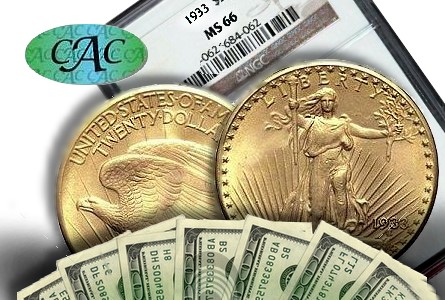The Certified Acceptance Corp. (CAC) is offering to pay the U.S. government $20 million for the 10 highly publicized 1933 Saint-Gaudens double eagles recently found to be government property.
The offer is “solid,” and could even be increased following closer inspection of the coins, said John Albanese, founder and president of the New Jersey-based firm.
 “Considering all the trouble the government is having with the deficit and the debt limit, this would be an easy way to cut 20 million dollars from the deficit,” Albanese said. “We’ll pay 20 million dollars sight-unseen – and maybe even more after inspection.
“Considering all the trouble the government is having with the deficit and the debt limit, this would be an easy way to cut 20 million dollars from the deficit,” Albanese said. “We’ll pay 20 million dollars sight-unseen – and maybe even more after inspection.
“I’ve read that the average American is in debt for $40,000,” he added. “This would pay the debt for 500 people. We see this as a way to do our share to help reduce the nation’s deficit.”
The 1933 “Saints” were at the center of a legal dispute stretching back to 2004, when they were submitted to the U.S. Treasury, ostensibly for authentication, by the family of a Philadelphia woman named Joan Langbord. The family said the coins had been found in the effects of Langbord’s father, Israel Switt, who died in 1990 at the age of 95.
The government determined that the coins were genuine – then confiscated them, saying they must have been stolen from the Philadelphia Mint because it would have been illegal to own them under Depression-era edicts and legislation in effect at the time.
Switt, a Philadelphia jeweler, was known to have sold coins he obtained from the nearby Mint, including a number of 1933 double eagles, but claimed to have acquired them legally through exchanges at the Mint for other coins. The Philadelphia Mint struck 445,500 examples of the ’33 Saint in early 1933 before production of gold coinage was halted and Americans were ordered to surrender most of the gold coins in their possession. All but a handful of the Saints were melted, making the survivors rare – but also subject to seizure in Uncle Sam’s eyes.
The Langbord family filed a civil suit seeking return of the 10 coins seized by the government. But on July 21, a Philadelphia jury decided that the coins rightfully belonged to the government.
A single specimen of the 1933 Saint, seized in a government sting in 1996, was sold at auction in 2002 after it came to light that Egypt’s King Farouk had been granted a U.S. export license for the coin after buying it in 1944. The coin brought $7.59 million, still the highest price ever paid at auction for a single coin.
There is general agreement that the price per coin would be lower, at least initially, if 10 more examples came on the market. But Albanese is confident that CAC would be able to recoup the $20 million – or $2 million per coin – it is offering.
“Seven or eight already are spoken for,” he said. “I have at least that many buyers ready and willing to purchase these coins if my offer is accepted by the government. And I wouldn’t mind at all if we ended up with the other two or three in our inventory.”
Albanese said CAC’s offer also is motivated by concern over what might happen to the 10 rare Saints now that the government controls their fate.
“I’d hate to see them melted. That would be a mistake,” he declared. “These are an important part of our numismatic heritage, and they should be entrusted to people who value and respect our nation’s coinage tradition.”
Albanese said the $20-million offer comes with “minimal contingencies.”
“This is not a publicity stunt; this is a serious offer,” he said. “And given the state of the economy, we feel it’s an offer that deserves serious consideration from the government.”
Since its inception in late 2007, CAC has become widely known and highly respected for its evaluation program. CAC experts examine coins previously certified by either the Professional Coin Grading Service (PCGS) or the Numismatic Guaranty Corporation of America (NGC), then affix a distinctive green sticker to the holder of each coin which, in their judgment, fully merits the grade that was assigned.
Some dealers and collectors are not as familiar with CAC’s emergence as a major buyer and seller of rare coins. To date, the company has purchased more than $200 million worth of coins. It also has processed more than 200,000 evaluation submissions with declared insurance value totaling more than $1 billion.
Further information about the company can be found at its Web site, www.caccoin.com.





$20 million? Hah! Based on the auction of the one “legal” 1933 that brought in approximately $7 million, I would say the ten should go for at least $60 million + $200 to monetize them.
According to the official Treasury website they will not monitize any more of these coins effectively blocking future public sales. what’s up with that? These should be in museums or something so we can see what FDR stole from the public.
cannot believe the family was so dumb as to trust the gov for authentification. If unsure, just presenting one for authentification would have been acceptable. The old man was brilliant-the grandkids not so much so….